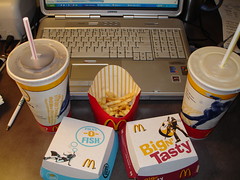I’d be willing to bet that almost everyone in America has visited McDonald's at least once in their lives. And I bet that, with some small exceptions, that you had a similar experience wherever you went.
McDonald's was the first job I ever had. I started working there in Englewood, Colo., when I was 15 (just before my 16th birthday) until I was almost 18. In my three years there, I learned a lot about human nature a few other things that helped me in the field of public relations.
As such, I have always felt a general affinity with McDonald's, even though I know the food isn’t exactly good for me. So, when Bob Langert, Senior Director for Corporate Responsibility for McDonald's, and author of the Open for Discussion Blog, asked bloggers to give him suggestions for his new blog, I responded with a few tips.
He volleyed, asking me to tell him what I learned (and everyone else), as a crew member at McDonald's. I've given it a little thought and there are three big lessons I learned that I carry with me today in my practice of public relations.
Know Your Audience
I made biscuits every day in the 5 a.m. shift before I went to school. I loved that shift because there were five or six regulars that would wait outside the doors of the restaurant until it opened. We usually had their breakfast, coffee or whatever they usually ordered on the counter when they walked in the door. If it was cold we would let them in a little early. In PR, knowing who you are serving and meeting their preferences is the key to unlocking loyalty.
The Power of Having and Working a Plan
Everything at McDonald's was regimented. We wore the same uniform, followed detailed processes for readying food, observed minimum wait times in the drive-thru (2 minutes max) and even had systems for bagging food. Drinks first, salads, then sandwiches and finally fries (to make sure they stayed hot). The manager would call to the grill in anticipation of how much food we needed. Everything was timed and customers were generally happy with the food served up by this otherwise motley crew. Likewise, in PR it is important to have a plan in place so that you aren’t always running from crisis to crisis.
How to Shift Gears in a Crisis
Picture this, a bus with more than 50 kids arrives and their chaperones in the restaurant and you have enough food for about 10, the average crowd at that time of day. It takes a good two to three minutes to get 20 hamburgers made and don’t even ask for a filet of fish, fry times are longer – which also means we don’t have enough fries. What do you do? Well, you innovate within the plan. We took orders and “parked” the customers to the side so that the lines didn’t get out of hand. We pulled a person from the register to fill orders and the manager kept up with the fries, taking pressure off of the front line. We then handed out free kids cones to appease the crowd.
In a PR, when a crisis hits, it is important to know who does what. The McDonald’s system makes that apparent, everyone has defined roles, so the manager can easily make a few tweaks to “hone the plan” in action.
A PR crisis plan should do the same.
